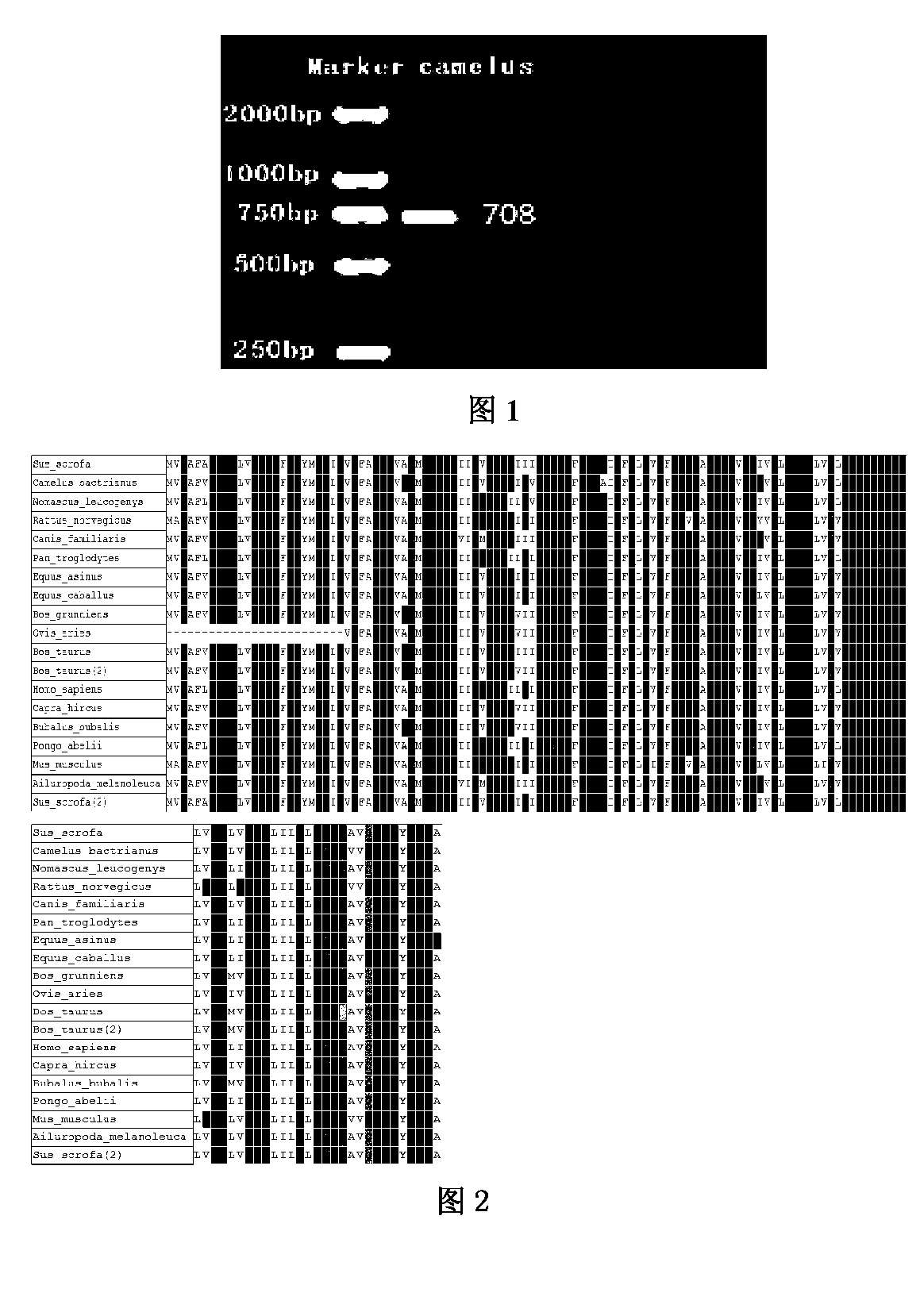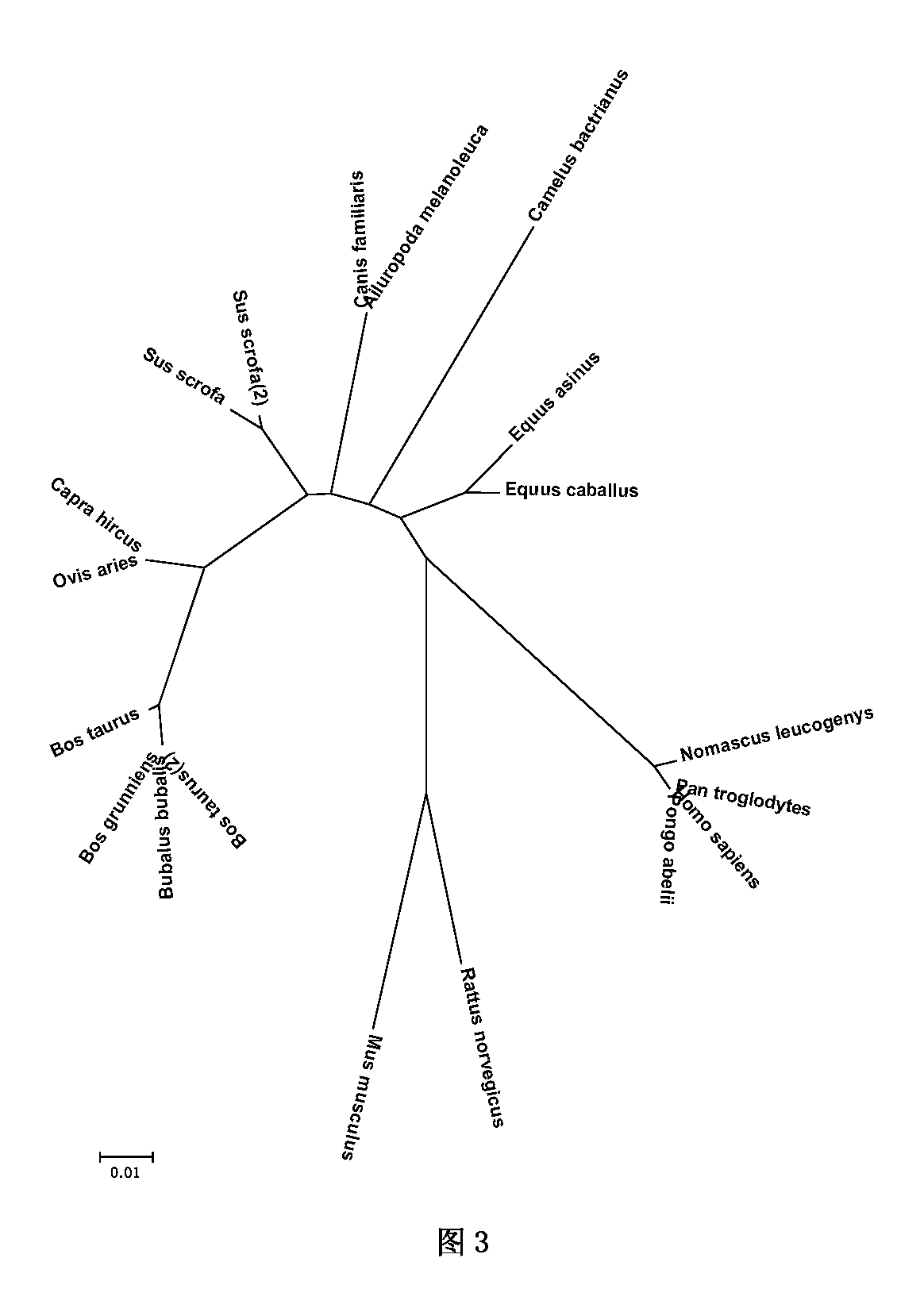Bactrian camel H-FABP protein gene, recombinant protein and cloning method thereof
A technology for recombining proteins and Bactrian camels, which is applied in the field of genetic engineering, can solve problems such as cloning and obtaining the encoded protein sequence of Bactrian camel H-FABP gene.
- Summary
- Abstract
- Description
- Claims
- Application Information
AI Technical Summary
Problems solved by technology
Method used
Image
Examples
Embodiment 1
[0030] Example 1, a Bactrian camel H-FABP protein gene, the nucleotide sequence of the gene has the sequence shown in SEQ ID NO.1. The new gene sequence obtained by using the total RNA in the liver tissue of Bactrian camel as a template, referring to the homologous sequence of the H-FABP protein gene of bovine, human, mouse and other species to design primers, and performing reverse transcription PCR. The cDNA sequence of camel H-FABP protein gene is shown in SEQ ID NO.1.
[0031] According to actual needs, the above-mentioned Bactrian camel H-FABP protein gene can be further optimized or / and improved:
[0032] The nucleotide sequence of the Bactrian camel H-FABP protein gene has the sequence of 46-661 in SEQ ID NO.1. In SEQ ID NO.1, the length of the RT-PCR product is 708bp, and the electrophoresis results are shown in Figure 1, wherein the 46-48 position is the start codon ATG, the 659-661 position is the stop codon TGA, and the 46-661 position is Coding protein domain (CD...
Embodiment 2
[0033] Example 2, a recombinant protein of Bactrian camel H-FABP protein gene.
[0034] According to actual needs, the recombinant protein of the above-mentioned Bactrian camel H-FABP protein gene can be further optimized or / and improved:
[0035] The amino acid sequence of the recombinant protein has the sequence shown in SEQ ID NO.2. See SEQ ID NO.2 for the protein coding sequence translated from the coding sequence (CDS) in the cDNA sequence of the Bactrian camel H-FABP protein gene according to the common codons.
[0036] The recombinant protein is a polypeptide having the amino acid sequence shown in SEQ ID NO.2, or a conservative variant polypeptide thereof, or an active fragment thereof, or an active derivative thereof.
[0037] By designing a pair of primers to obtain the Bactrian camel myosin gene from the Bactrian camel H-FABP protein, the nucleotide sequence information of the primer pair is as follows:
[0038]Forward primer, SEQ ID NO.3 (forward): 5'-ATGGTGGACGC...
Embodiment 3
[0040] Embodiment 3, a kind of cloning method of Bactrian camel H-FABP protein gene is characterized in that carrying out according to the following steps:
[0041] The first step, total RNA extraction
[0042] 1. Isolation
[0043] Bactrian camels were collected from Alxa League in Inner Mongolia, slaughtered quickly and liver samples were taken. The tissue samples were quickly frozen in liquid nitrogen and stored at -70°C. They were taken back to the laboratory for extraction of tissue total RNA.
[0044] 2. Total RNA isolation
[0045] (1) Preparation for RNA extraction
[0046] Glass products were soaked in 0.1M NaOH overnight, rinsed repeatedly with tap water, rinsed twice with distilled water, and baked at 180°C for 4 hours.
[0047] Soak the homogenizer and electrophoresis tank with 3% hydrogen peroxide for 20-30 minutes, and then rinse with 0.1% DEPC water. Since the uninactivated DEPC will affect the PCR reaction, it can be treated with 0.5% SDS.
[0048] Tips an...
PUM
 Login to View More
Login to View More Abstract
Description
Claims
Application Information
 Login to View More
Login to View More - R&D
- Intellectual Property
- Life Sciences
- Materials
- Tech Scout
- Unparalleled Data Quality
- Higher Quality Content
- 60% Fewer Hallucinations
Browse by: Latest US Patents, China's latest patents, Technical Efficacy Thesaurus, Application Domain, Technology Topic, Popular Technical Reports.
© 2025 PatSnap. All rights reserved.Legal|Privacy policy|Modern Slavery Act Transparency Statement|Sitemap|About US| Contact US: help@patsnap.com


